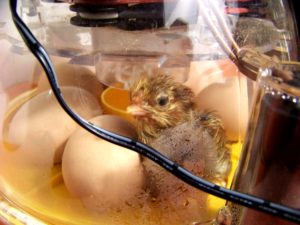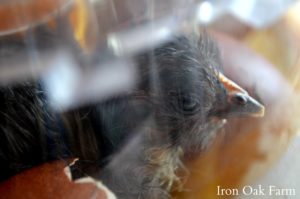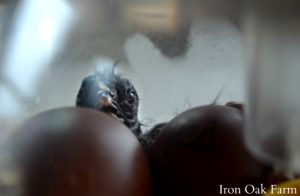 I just came in from our coops with a basket of eggs. These eggs will not be eaten. Instead, they will be going into my incubator. I mark the breed and the date with a pencil and set them in a labeled egg carton until I have enough to fill the incubator.
I just came in from our coops with a basket of eggs. These eggs will not be eaten. Instead, they will be going into my incubator. I mark the breed and the date with a pencil and set them in a labeled egg carton until I have enough to fill the incubator.
This is one of my favorite times of the year. I never grow bored with the miracle that is witnessed every time a chick breaks through the shell and comes into the world.
Pre-hatch
It takes approximately 21 days for a chick embryo to reach hatching age. By this time, the chick has completely filled the egg and has nowhere left to go but out.
On days 19 and 20 you may see the eggs wiggling a bit, and you may hear faint peeping through the shell.
The Pip
 The first stage of hatching starts with the pip. The pip is the initial crack of the eggshell that the chick makes with its egg tooth, a tiny hard nubbin on the end of its beak. This temporary appendage is designed specifically for hatching. The egg tooth will fall off within the first week as the chick grows.
The first stage of hatching starts with the pip. The pip is the initial crack of the eggshell that the chick makes with its egg tooth, a tiny hard nubbin on the end of its beak. This temporary appendage is designed specifically for hatching. The egg tooth will fall off within the first week as the chick grows.
The pip is usually a small triangular crack in the eggshell. The chick will work this area until it breaks open a small hole. You will see the chick working at this small space. You may get glimpses of the beak as it nibbles and wiggles at the small hole and will hear it peeping anxiously.
In a typical/normal hatch the chick may stay like this for quite a while an hour or two is not uncommon.
The Hinge Hatch
 As hatching progresses, the chick will press against the insides of the eggshell from top to bottom. The chick is coiled inside the small space and it will put pressure on the shell as it tries to straighten its body out. It will alternately help the progression by working at the center of the egg and dissecting it in two in a sort of hatch-line-equator.
As hatching progresses, the chick will press against the insides of the eggshell from top to bottom. The chick is coiled inside the small space and it will put pressure on the shell as it tries to straighten its body out. It will alternately help the progression by working at the center of the egg and dissecting it in two in a sort of hatch-line-equator.
Eventually, the egg will be connected by a small hinge of rubbery membrane. You will be able to see the chick’s body at this point between pushes. Usually, in one great movement, it will eventually break this last bit of membrane and come crashing out exhausted, wet and floppy.
Hatching is supposed to be a slow process. It can take several hours from the first pip to complete hatch. It’s not like in cartoons where you see the chick burst through the eggshell all in one blast.
The chick is still connected to the egg. It takes time for these membranes to dry and disconnect from the shell wall. The chick is also working on building strength.
In a normal hatch, the chick will take a few seconds to work at hatching. It may push with great force, then take a long break to recoup its strength.
Hatching Problems
 9 times out of 10, a difficult hatch is due to humidity problems. Usually, the humidity isn’t high enough, and the chick gets shrink-wrapped inside the shell.
9 times out of 10, a difficult hatch is due to humidity problems. Usually, the humidity isn’t high enough, and the chick gets shrink-wrapped inside the shell.
Shrinkwrap is where the inner membrane of the egg, the rubbery layer beneath the shell, starts to dry out. As it does, the membrane becomes tough and inflexible.
Often times the chick isn’t strong enough to breakthrough.
When to Assist
 Assisting in a hatch is more often than not a fruitless endeavor. It must be a last resort type of action. Often when a chick has been assisted in a hatch it will die a few hours to a few days later.
Assisting in a hatch is more often than not a fruitless endeavor. It must be a last resort type of action. Often when a chick has been assisted in a hatch it will die a few hours to a few days later.
I sometimes wonder if there is something more wrong when a chick is unable to break through on its own. Sort of nature’s cruel test of endurance.
So if there is nothing else to be done and the chick will die anyway, then you have nothing to lose but try to help.
Often, if you have a problem egg/chick. The other chicks will have already pipped and hatched while the problem egg is still in the pip stages.
Signs that you may need to step in:
- If the egg isn’t progressing and it’s been several hours
- If the membrane around the egg seems to be getting tough and shrinking, adding more humidity might help, but usually, at this point it’s too late.
To Assist
 Work very slowly, again the chick is still attached to the eggshell so any sudden movements can cause the chick to bleed to death.
Work very slowly, again the chick is still attached to the eggshell so any sudden movements can cause the chick to bleed to death.
Only remove a small bit at a time and see if the chick can progress on its own. Often you may see the membrane is sort of shredded in strips that the chick can’t break. Try gently tearing these strips and see if the chick can take it from there.
Give the chick some time between assisting. Always remember to move slowly and only remove parts of the shell that are absolutely necessary.
If you’re planning on hatching out chicks this spring, research how the humidity in your specific incubator is regulated. It’s a very important factor that can make or break a successful hatch.













6 Comments
Please, passed 21 days and eggs has not broken yet. What i do?
ThankYou for Information!
So I have a very small 4 egg incubator. One of the baby ducks are starting to hatch. Will he be ok hatching I’m the incubator or should I move him to the self made incubator so he has more room.
A quail made a nest in my raised succulent garden. Fourteen eggs were hatched all chicks were running around and following mom. They took residence in another part of our garden. We couldn’t wait to see them the next morning. They were gone. AND SO WERE THE SHELLS!!! What does the mom do with the shells?
Linda, This is an excellent question. The moms eat the shells for their calcium and trace minerals.
What about a hen hatching eggs? When do you take the chicks away?